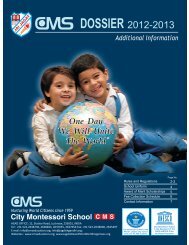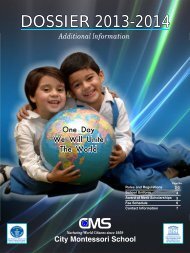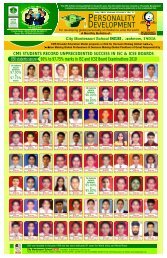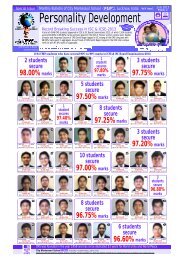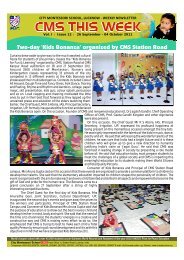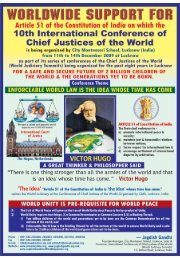Download the Speeches of all Hon'ble Chief Justices & Judges in ...
Download the Speeches of all Hon'ble Chief Justices & Judges in ...
Download the Speeches of all Hon'ble Chief Justices & Judges in ...
Create successful ePaper yourself
Turn your PDF publications into a flip-book with our unique Google optimized e-Paper software.
5th International Conference <strong>of</strong> <strong>Chief</strong> <strong>Justices</strong> <strong>of</strong> <strong>the</strong> WorldAddress byHon’ble Dr Justice Jose Maria Calvario AntunesInternational Judge, Court <strong>of</strong> Appeal <strong>of</strong> East TimorI will try to give you a sole perspective and a po<strong>in</strong>t <strong>of</strong> view <strong>of</strong> a very delicate andsensitive issue, which is <strong>the</strong> problem <strong>of</strong> <strong>the</strong> Separated Children, <strong>the</strong> Child soldiers and<strong>the</strong> Legal Framework to prevent such abuses.The Separated ChildrenI started with <strong>the</strong> example <strong>of</strong> East Timor as I am currently a Judge <strong>of</strong> <strong>the</strong> Court <strong>of</strong>Appeal, <strong>the</strong> highest court <strong>in</strong>stance <strong>in</strong> that country.After <strong>the</strong> violence that erupted <strong>in</strong> East Timor <strong>in</strong> 1999, 4500 children had become separatedfrom <strong>the</strong>ir parents, ei<strong>the</strong>r by co<strong>in</strong>cidence (<strong>the</strong> general chaos that reigned <strong>in</strong> East Timor),through crim<strong>in</strong>al acts (abductions by military forces) or even deliberate and well-mean<strong>in</strong>gaction by parents who gave <strong>the</strong>ir children <strong>in</strong>to <strong>the</strong> care <strong>of</strong> educational <strong>in</strong>stitutions orrelatives who lived outside <strong>the</strong> conflict zone for greater safety.Once <strong>the</strong> background <strong>of</strong> <strong>the</strong> separation and <strong>the</strong> situation <strong>of</strong> <strong>the</strong> child, parents and caretaker had been assessed, UNHCR(<strong>in</strong> cooperation with Red Cross Societies or reliable NGOs) would re-establish communication or even arrange visitsbetween <strong>all</strong> persons concerned and assist <strong>the</strong> families <strong>in</strong> f<strong>in</strong>d<strong>in</strong>g a solution <strong>in</strong> <strong>the</strong> best <strong>in</strong>terest <strong>of</strong> <strong>the</strong> child. The participantslearned <strong>of</strong> <strong>the</strong> many pitf<strong>all</strong>s <strong>in</strong> this process, such as <strong>the</strong> <strong>in</strong>accessibility <strong>of</strong> children sent to distant islands <strong>of</strong> <strong>the</strong> Indonesianarchipelago, presented logistical ch<strong>all</strong>enges. But we wish that <strong>the</strong> sent away children could return to <strong>the</strong>ir country, to <strong>the</strong>irhomes and to <strong>the</strong>ir families where <strong>the</strong>y can be re<strong>in</strong>tegrated successfully. This was a heavy work that has been done <strong>in</strong> EastTimor and besides <strong>the</strong> fact that <strong>the</strong> situation has not been completely solved, it is however on <strong>the</strong> good way to a good end.Although, this almost happy end<strong>in</strong>g is not always like that!The def<strong>in</strong>ition <strong>of</strong> “separate children” has been accepted <strong>in</strong> <strong>the</strong> <strong>in</strong>ternational community as “...children under 18 years <strong>of</strong>age who are outside <strong>the</strong>ir country <strong>of</strong> orig<strong>in</strong> and separated from both parents or previous/legal customary primarycaregiver.”.This def<strong>in</strong>ition is based on <strong>the</strong> Convention on <strong>the</strong> Rights <strong>of</strong> <strong>the</strong> Child which was ratified by almost <strong>all</strong> <strong>the</strong> countries, where<strong>the</strong> 18 years <strong>of</strong> age is recognized as <strong>the</strong> year <strong>of</strong> <strong>the</strong> majority.A vast majority <strong>of</strong> separated children rema<strong>in</strong> with<strong>in</strong> <strong>the</strong>ir regions <strong>of</strong> orig<strong>in</strong>, but a sm<strong>all</strong> and <strong>in</strong>creas<strong>in</strong>g number – currentlyestimated around 20,000 each year, most <strong>of</strong> <strong>the</strong>m older boys - seek refuge <strong>in</strong> different countries around <strong>the</strong> world. Thepractical problems that separated children face on arrival <strong>in</strong> a new country are immense. The Director <strong>of</strong> <strong>the</strong> UNHCR(UnitedNations Humanitarian Commission <strong>of</strong> Refugees ) Bureau for Europe has said:“Separated children are still be<strong>in</strong>g deta<strong>in</strong>ed regularly <strong>in</strong> some countries and deported without necessary safeguards;<strong>in</strong>creas<strong>in</strong>g numbers <strong>of</strong> separated children disappear ei<strong>the</strong>r shortly after arrival, dur<strong>in</strong>g <strong>the</strong> procedure or after be<strong>in</strong>gf<strong>in</strong><strong>all</strong>y rejected and run a high risk <strong>of</strong> becom<strong>in</strong>g victims <strong>of</strong> traffick<strong>in</strong>g and o<strong>the</strong>rcrimes; guardianship systems are <strong>in</strong>adequate; <strong>in</strong> several countries specialisedreception conditions are still lack<strong>in</strong>g…”The legal framework that is used, is largely based on <strong>the</strong> 1997 Council Resolution onUnaccompanied M<strong>in</strong>ors. Although <strong>the</strong> resolution provides some protection, it is notleg<strong>all</strong>y b<strong>in</strong>d<strong>in</strong>g, nor does it reflect adequately <strong>all</strong> <strong>the</strong> pr<strong>in</strong>ciples <strong>of</strong> <strong>the</strong> UN Convention on<strong>the</strong> Rights <strong>of</strong> <strong>the</strong> Child (CRC).Hon’ble Dr Justice J. M. C. Antunes,Internatioanal Judge, Court <strong>of</strong> Appeal <strong>of</strong>East Timor receiv<strong>in</strong>g <strong>the</strong> ConferenceMementoHon’ble Dr Justice J. M. C. Antunes,International Judge, Court <strong>of</strong> Appeal <strong>of</strong>East Timor address<strong>in</strong>g <strong>the</strong> ConferenceIn relation to separated children, a number <strong>of</strong> International legislative proposals havelowered standards. For example, Article 4.1 <strong>of</strong> <strong>the</strong> “Family Reunification Directive”<strong>all</strong>ows Member States to derogate from <strong>the</strong> pr<strong>in</strong>ciple that ‘child’ should be def<strong>in</strong>ed up to--59--



